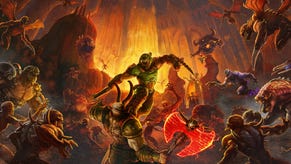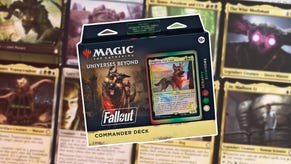How Doom Eternal Looked to Mario Kart in Balancing Its Difficulty
Co-Director Hugo Martin tells USgamer about how id Software's rethinking difficulty for Doom Eternal.
This article first appeared on USgamer, a partner publication of VG247. Some content, such as this article, has been migrated to VG247 for posterity after USgamer's closure - but it has not been edited or further vetted by the VG247 team.
When Hugo Martin asks me what difficulty I've been playing the latest Doom Eternal demo on, I sheepishly say Hurt Me Plenty, the second notch above what's basically "easy mode." The creative director doesn't blink though. In fact, in an opening presentation before siccing the press upon Doom Eternal's first three hours, Martin accentuated how id Software has rethought its approach to difficulty in this year's hellish sequel.
In Doom Eternal, even lower difficulty levels are intended to feel just as intense as Nightmare or Ultra Nightmare. According to Martin, it's that way so everyone can get the fair Doom experience. (Or rather, a properly unfair Doom experience.)
Martin has an interesting point of comparison for the renewed difficulty experiences—which yes, again includes a permadeath mode, this time called Extra Life Mode. It's a comparison everyone can pump the brakes for: Mario Kart.
In Mario Kart, Martin argues, the only thing that changes per skill setting is speed. 50cc is just slower than 150cc, but they all require the same skill. "In Mario Kart if I play on easy, it's the slowest setting. I mean, I'm still needing to power slide. I still need to use my resources. I still need to do all the same things; hit the jump the same way," he says. "The only difference is that on the hardest setting, it's just way f**king faster, you know? So I think that's our goal."
Doom Eternal, similarly, will in essence be just that: way f**king faster. If all goes according to id Software's plan, the deeper you get into Doom Eternal on a lower difficulty setting, maybe the less challenge you start to feel—less and less you'll feel those tense moments with the guitar shred where you're on the brink of death. Maybe, just maybe, they'll bump up to Nightmare or higher on a whim.
Doom Eternal's new approach to difficulty is based in part on feedback from the previous game, Martin says. "The game changed too much from each difficulty last time around, which I think discouraged people to play it at higher difficulties."
An example Martin mentions is how enemy attacks, like a fireball for instance, just felt overall more accurate than lower difficulties. Skill had less to do with the different difficulty levels rather than it just being a general sense of being more, I suppose, dickish. "In hindsight, that was the decision that we made and at the time it seemed good."
This time around, however, id Software wants replayability to be "very high"—it wants all sorts of players to be encouraged to give Doom Eternal's campaign more than just one go. "The only thing that changes is the number of decisions you're being asked to make per second and the number of mistakes you're allowed to make," says Martin. "So the game that you play, if you drop down to easy, is basically the same exact game, the same exact combat loop. You're gonna be doing the same exact things that you would be doing on Nightmare. The only thing is to just be doing it way faster." That's not to say the higher difficulties are easier now either. Martin says the opposite is true; it just scales at a better rate now.

The central loop—the up close glory kills to soak health, the new flame belch that sets foes on fire and drops armor, the chainsaw that nets you ammo—remains unchanged from difficulty to difficulty. According to Martin, it's really just that same tense loop made faster and overall harder. "[E]verything you learned on the lower difficulty will carry over to the next difficulty," he says, "which will make transitioning to higher difficulties, I think, that much more inviting to players."
Doom Eternal, in all its brutal glory, is coming to PC (including Google Stadia), PlayStation 4, and Xbox One on March 20. Its Nintendo Switch port, in development with port aficionados Panic Button, is headed to the platform sometime later in 2020. For more on what we played of Doom Eternal, read here about our impressions of its opening three hours.
.png?width=690&quality=80&format=jpg&auto=webp)

















